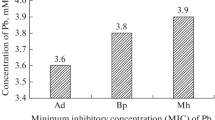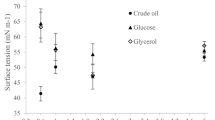Abstract
This study describes the potential application of lipopeptide biosurfactants in removal of petroleum hydrocarbons and heavy metals from the soil samples collected from industrial dumping site. High concentrations of heavy metals (like iron, lead, nickel, cadmium, copper, cobalt and zinc) and petroleum hydrocarbons were present in the contaminated soil samples. Lipopeptide biosurfactant, consisting of surfactin and fengycin was obtained from Bacillus subtilis A21. Soil washing with biosurfactant solution removed significant amount of petroleum hydrocarbon (64.5 %) and metals namely cadmium (44.2 %), cobalt (35.4 %), lead (40.3 %), nickel (32.2 %), copper (26.2 %) and zinc (32.07 %). Parameters like surfactant concentration, temperature, agitation condition and pH of the washing solution influenced the pollutant removing ability of biosurfactant mixture. Biosurfactant exhibited substantial hydrocarbon solubility above its critical micelle concentration. During washing, 50 % of biosurfactant was sorbed to the soil particles decreasing effective concentration during washing process. Biosurfactant washed soil exhibited 100 % mustard seed germination contradictory to water washed soil where no germination was observed. The results indicate that the soil washing with mixture of lipopeptide biosurfactants at concentrations above its critical micelle concentration can be an efficient and environment friendly approach for removing pollutants (petroleum hydrocarbon and heavy metals) from contaminated soil.



Similar content being viewed by others
References
Adam G, Duncan H (2002) Influence of diesel fuel on seed germination. Environ Pollut 120:363–370
Almeida R, Mucha AP, Teixeira C, Bordalo AA, Almeida CM (2013) Biodegradation of petroleum hydrocarbons in estuarine sediments: metal influence. Biodegradation 24:111–123
Coutte F, Lecouturier D, Yahia SA, Leclere V, Bechet M, Jacques P, Dhulster P (2010) Production of surfactin and fengycin by Bacillus subtilis in a bubbleless membrane bioreactor. Appl Microbiol Biotechnol 87:499–507
Dahrazma B, Mulligan CN (2007) Investigation of the removal of heavy metals from sediments using rhamnolipid in a continuous flow configuration. Chemosphere 69:705–711
de Faria AF, Teodoro-Martinez DS, de Oliveira Barbosa GN et al (2011) Production and structural characterization of surfactin (C14/Leu7) produced by Bacillus subtilis isolate LSFM-05 grown on raw glycerol from the biodiesel industry. Process Biochem 46:1951–1957
Dermont G, Bergeron M, Mercier G, Richer-Lafleche M (2008) Soil washing for metal removal: a review of physical/chemical technologies and field applications. J Hazard Mater 152:1–31
Guo Y, Wu K, Huo X, Xu X (2011) Sources, distribution, and toxicity of polycyclic aromatic hydrocarbons. J Environ Health 73:22–25
Hong KJ, Tokunaga S, Kajiuchi T (2002) Evaluation of remediation process with plant-derived biosurfactant for recovery of heavy metals from contaminated soils. Chemosphere 49:379–387
Isa MHM, Coraglia DE, Frazier RA, Jauregi P (2007) Recovery and purification of surfactin from fermentation broth by a two-step ultrafiltration process. J Membr Sci 296:51–57
Kaya A, Yukselen Y (2005) Zeta potential of soils with surfactants and its relevance to electrokinetic remediation. J Hazard Mater 120:119–126
Kilic E, Font J, Puig R, Colak S, Celik D (2011) Chromium recovery from tannery sludge with saponin and oxidative remediation. J Hazard Mater 185:456–462
Kim PI, Ryu J, Kim YH, Chi YT (2010) Production of biosurfactant lipopeptides iturin A, fengycin and surfactin A from Bacillus subtilis CMB32 for control of Colletotrichum gloeosporioides. J Microbiol Biotechnol 20:138–145
Lai CC, Huang YC, Wei YH, Chang JS (2009) Biosurfactant-enhanced removal of total petroleum hydrocarbons from contaminated soil. J Hazard Mater 167:609–614
Mulligan CN (2005) Environmental applications for biosurfactants. Environ Pollut 133:183–198
Mulligan CN, Yong RN, Gibbs BF, James S, Bennett HPJ (1999) Metal removal from contaminated soil and sediments by the biosurfactant surfactin. Environ Sci Technol 33:3812–3820
Mulligan CN, Yong RN, Gibbs BF (2001) Heavy metal removal from sediments by biosurfactants. J Hazard Mater 85:111–125
Pacwa-Plociniczak M, Plaza GA, Piotrowska-Seget Z, Cameotra SS (2011) Environmental applications of biosurfactants: recent advances. Int J Mol Sci 12:633–654
Raaijmakers JM, de Bruijn I, Nybroe O, Ongena M (2010) Natural functions of lipopeptides from Bacillus and Pseudomonas: more than surfactants and antibiotics. FEMS Microbiol Rev 34:1037–1062
Tang J, Wang M, Wang F, Sun Q, Zhou Q (2011) Eco-toxicity of petroleum hydrocarbon contaminated soil. J Environ Sci (China) 23:845–851
Thimon L, Peypoux F, Wallach J, Michel G (1993) Ionophorous and sequestering properties of surfactin, a biosurfactant from Bacillus subtilis. Colloids Surf B Biointerfaces 1:57–62
Urum K, Grigson S, Pekdemir T, McMenamy S (2006) A comparison of the efficiency of different surfactants for removal of crude oil from contaminated soils. Chemosphere 62:1403–1410
Wang S, Mulligan CN (2009) Rhamnolipid biosurfactant-enhanced soil flushing for the removal of arsenic and heavy metals from mine tailings. Process Biochem 44:296–301
Wei YH, Wang LC, Chen WC, Chen SY (2010) Production and characterization of fengycin by indigenous Bacillus subtilis F29-3 originating from a potato farm. Int J Mol Sci 11:4526–4538
Zhu L, Feng S (2003) Synergistic solubilization of polycyclic aromatic hydrocarbons by mixed anionic–nonionic surfactants. Chemosphere 53:459–467
Acknowledgements
The authors thank the Director, IMTECH, for providing the facilities for this work. AKS is thankful to UGC for his fellowship.
Author information
Authors and Affiliations
Corresponding author
Additional information
Responsible editor: Philippe Garrigues
Rights and permissions
About this article
Cite this article
Singh, A.K., Cameotra, S.S. Efficiency of lipopeptide biosurfactants in removal of petroleum hydrocarbons and heavy metals from contaminated soil. Environ Sci Pollut Res 20, 7367–7376 (2013). https://doi.org/10.1007/s11356-013-1752-4
Received:
Accepted:
Published:
Issue Date:
DOI: https://doi.org/10.1007/s11356-013-1752-4




